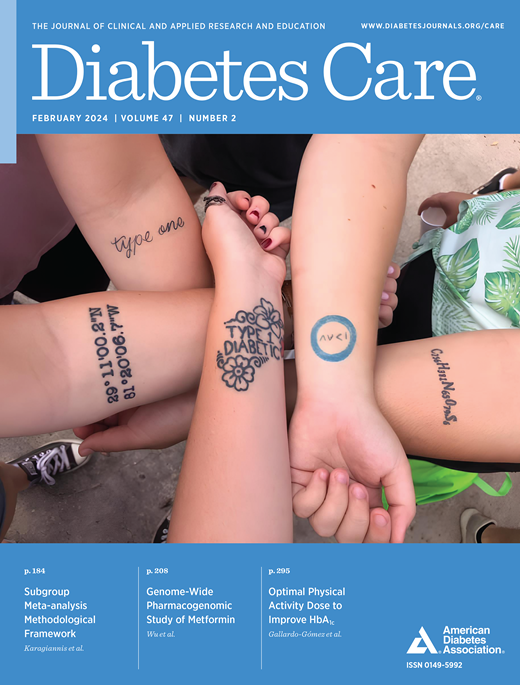利用尿Titin水平预测2型糖尿病患者肌肉减少症的发生:一项日本前瞻性队列研究
IF 16.6
1区 医学
Q1 ENDOCRINOLOGY & METABOLISM
引用次数: 0
摘要
目的研究尿titin对日本2型糖尿病患者肌肉减少症的预测能力。研究设计和方法测量基线尿titin水平,并使用亚洲肌肉减少症工作组(AWGS) 2019标准每年评估肌肉减少症。Kaplan-Meier曲线、Cox模型和随时间变化的受试者工作特征分析用于评估肌肉减少症。结果:在444名参与者中(中位随访1078天),41人发生了肌肉减少症。高titin水平与肌少症风险升高相关(log-rank P = 0.04)。Cox模型将titin与肌肉减少症(校正风险比/ SD 1.37, 95% CI 1.05-1.77, P = 0.019)和低肌力相关。风险估计在亚组中是一致的,包括年龄≥70岁的人、男性、BMI和lt;25 kg/m2, HbA1c≥7%,估计肾小球滤过率≥60 mL/min/1.73 m2(相互作用P < 0.05)。结论尿titin水平升高可预测2型糖尿病患者的肌肉减少症和低肌力,支持其作为无创生物标志物的应用。本文章由计算机程序翻译,如有差异,请以英文原文为准。
Prediction of Sarcopenia Onset in Type 2 Diabetes Using Urinary Titin Levels: A Japanese Prospective Cohort Study
OBJECTIVE The predictive power of urinary titin for incident sarcopenia was studied in Japanese individuals with type 2 diabetes. RESEARCH DESIGN AND METHODS Baseline urinary titin levels were measured, and sarcopenia was evaluated annually using the Asian Working Group for Sarcopenia (AWGS) 2019 criteria. Kaplan-Meier curves, Cox models, and time-dependent receiver operating characteristic analyses were used to assess incident sarcopenia. RESULTS Among 444 participants (median follow-up, 1,078 days), 41 developed sarcopenia. The high titin tertile was associated with an elevated sarcopenia risk (log-rank P = 0.04). Cox models associated titin with sarcopenia (adjusted hazard ratio per SD 1.37, 95% CI 1.05–1.77, P = 0.019) and low muscle strength. Risk estimates were consistent across subgroups, including those aged ≥70 years, men, individuals with BMI <25 kg/m2, HbA1c ≥7%, and estimated glomerular filtration rate ≥60 mL/min/1.73 m2 (P for interaction > 0.05). CONCLUSIONS Elevated urinary titin levels predict sarcopenia and low muscle strength in individuals with type 2 diabetes, supporting its use as a noninvasive biomarker.
求助全文
通过发布文献求助,成功后即可免费获取论文全文。
去求助
来源期刊

Diabetes Care
医学-内分泌学与代谢
CiteScore
27.80
自引率
4.90%
发文量
449
审稿时长
1 months
期刊介绍:
The journal's overarching mission can be captured by the simple word "Care," reflecting its commitment to enhancing patient well-being. Diabetes Care aims to support better patient care by addressing the comprehensive needs of healthcare professionals dedicated to managing diabetes.
Diabetes Care serves as a valuable resource for healthcare practitioners, aiming to advance knowledge, foster research, and improve diabetes management. The journal publishes original research across various categories, including Clinical Care, Education, Nutrition, Psychosocial Research, Epidemiology, Health Services Research, Emerging Treatments and Technologies, Pathophysiology, Complications, and Cardiovascular and Metabolic Risk. Additionally, Diabetes Care features ADA statements, consensus reports, review articles, letters to the editor, and health/medical news, appealing to a diverse audience of physicians, researchers, psychologists, educators, and other healthcare professionals.
 求助内容:
求助内容: 应助结果提醒方式:
应助结果提醒方式:


